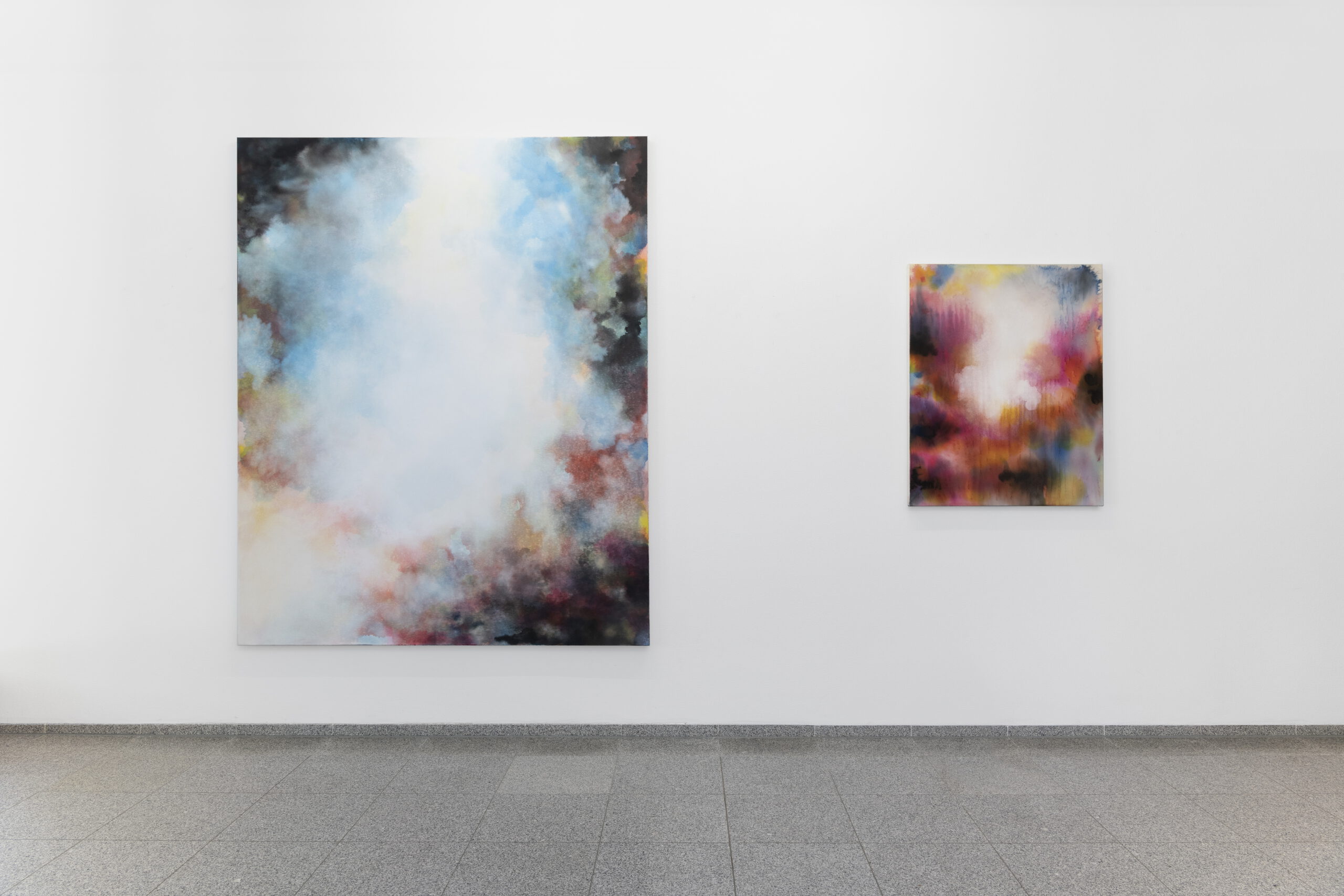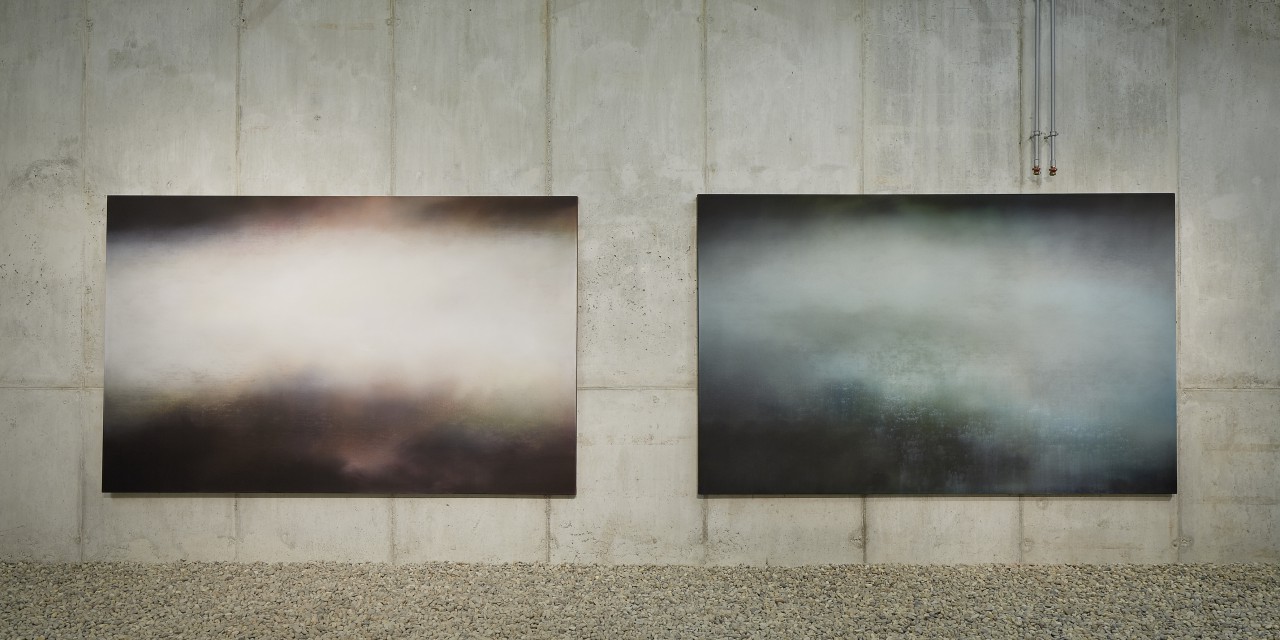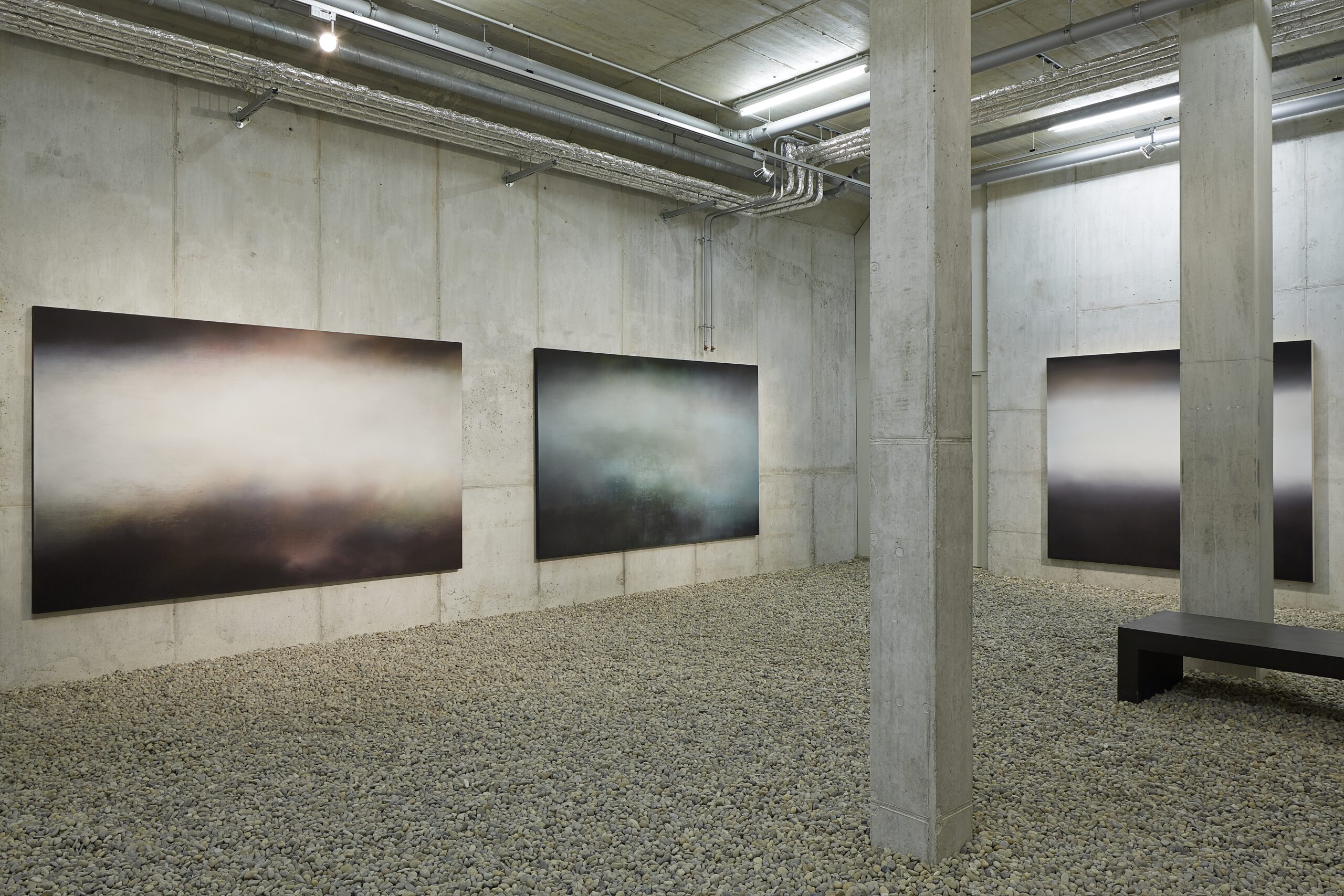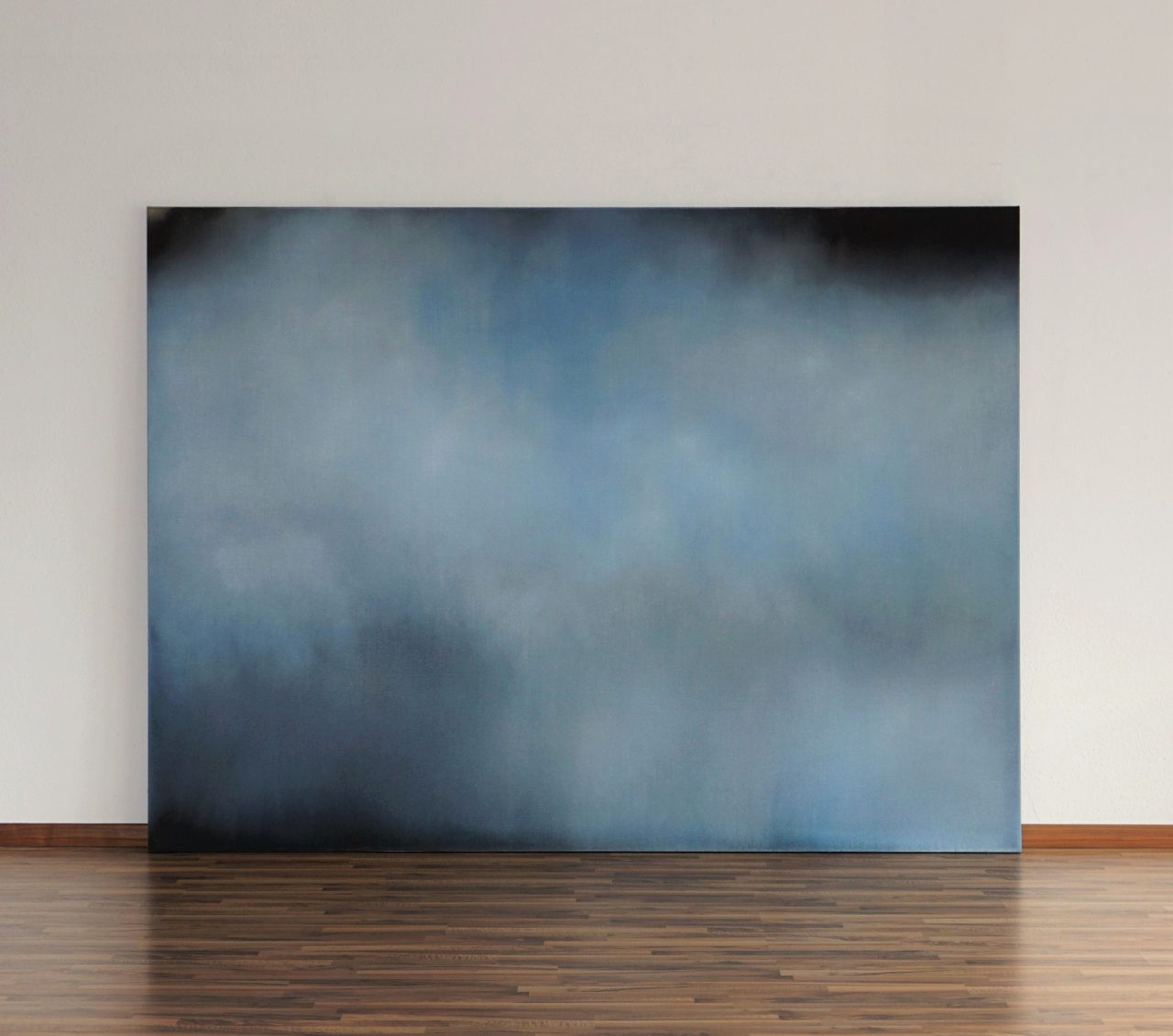
Philipp Haager
Dome Painting (A Parrot‘s Cake), 2020
100,0 x 80,0 x 3,8 cm | 39,4 x 31,5 x 1,5 inch
6.500,00 € excl. VAT
...Page is loading...
Published 20/05/2016 | Updated 11/02/2023
PHILIPP HAAGER'S DOME PAINTINGS
by Thomas Groetz
With the Dome Paintings, a pictorial form suddenly appeared in Philipp Haager’s work in 2019 that at first glance seems to come out of nowhere. It does relate to, albeit not derive from, the artist’s previous paintings, which feature gently modulated surfaces created through varying tonal values, or in other cases layers of paint gradually built up to seal the pictorial...
PHILIPP HAAGER'S DOME PAINTINGS
by Thomas Groetz
With the Dome Paintings, a pictorial form suddenly appeared in Philipp Haager’s work in 2019 that at first glance seems to come out of nowhere. It does relate to, albeit not derive from, the artist’s previous paintings, which feature gently modulated surfaces created through varying tonal values, or in other cases layers of paint gradually built up to seal the pictorial skin. But that sealing and locking in is precisely what is missing in the Dome Paintings, and it is replaced by its virtual opposite: the explosive parting of those layers. The painting method no longer aims at homogeneity and meticulously executed colour gradients, or nearly impenetrable layers, but manifests itself beyond any centred build-up of planes in the visible addition of individual elements.
The pictorial tension inherent in the Dome Paintings consists primarily in the contrast between directly applied accumulation and “evaporation” across the surface, between dense colours, selective agglomeration and a neutralising, bright flatness in the middle of each picture. “Revealing” his painterly means by showcasing his brushstrokes – and by extension his personal temperament – the artist places the alla-prima Dome Paintings in a clearer historical frame of reference than his earlier painting series permitted. Associations with the Abstract Expressionism of the war and post-war period as well as with the tradition of colour field painting from Mark Rothko to Gotthard Graubner play a role here. The emancipation and expressiveness of Pointillism may also come to mind, a microcosm of dots and flecks in contrasting colours that creates a completely different kind of flickering surface than the airy and by turns dense veils of darkness and lightening that characterise, for example, Haager’s Deep Field Nebula Paintings.
A further factor in the essential difference between the painting typologies is that the artist has dubbed his latest series Dome Paintings, thus suggesting a metaphorical reference to cultural history. While the description Deep Field Nebula Paintings seems to be more of a neutral, scientific term, the name Dome Paintings links these works to a topos, or even a concrete manifestation, that can be connected with Christian, but not only Christian, religious practice. The word “dome” in English calls to mind the cupola of a church, and the German word Dom means cathedral, so that this designation evokes a kind of crystallisation point for an assumed entity that transcends the human as category. For such manifestations of the divine, the erstwhile Christian Occident developed corresponding vessels, i.e. architectures, rendered in stone and on a scale far exceeding that of the human body.
The dome is a central element of this architecture, a vault spanning the crossing of church buildings with a cross-shaped floor plan. In and with the dome, a stereometric volume above the crossing gives the illusion of dissolving as it soars upward into an expanded, otherworldly form of existence. The pictorial architectures of the Dome Paintings seem to not only hint at but make palpable the alternative possibility of experience offered by such domes; the seeing eye is drawn into the centre of the picture by accumulations of colour that practically pile up at the edges of the rectangular picture surfaces to build an ethereal fabric of milky-white colour veils. The composition establishes an upright rhombus on the vertical or square canvases, the corners of which, however, are in most cases bevelled into ovals.
The resulting oval or almond shape has had a special meaning in the history of art since the Middle Ages as a mandorla, a separate space of existence and protection surrounding extraordinary figures such as Jesus Christ or the Virgin Mary. Later, the oval form was particularly common in Baroque architecture – as an elliptical floor plan or a dome. The stretching of the balanced, tranquil form of the circle into an oval connotes activation and intensification on the one hand but also the blurring or synthesis of the “polarities” of square and circle on the other.
Haager’s Dome Paintings, which not only refer to the architectural form of the dome but can also be related to paintings adorning the insides of domes or on ceilings, resonate – in a subtle fashion – with the artist’s own cultural affinity to his southwest German homeland. (Baden-Württemberg has numerous Baroque churches, as do the neighbouring countries of Austria and Switzerland.) At the same time, the Dome Paintings give the impression of an artist who is taking off in new directions. Although these paintings may not necessarily call into question the optimised and in some cases hermetic surface formations of his earlier pictures, Haager is undertaking here a new and different mode of operation that seems to function more analytically than synthetically: the closed surface has become fragmented, so that the image – as if under the microscope – reveals what it is made of. Haager offers us a view of atoms or cell clusters, of the moving individual pieces and interdependent forces from which the whole of the world emerges. This world is not only the superficial reality of molecules, however, but perhaps an even more finely articulated, transcendent sphere whose existence and effects are revealed to us by art.
CLOUDS & NEBULA
by Hansjörg Fröhlich
(a particle's story)
Hubble Deep Field is what NASA calls the deepest image of the universe ever recorded in the range of visible light. The region of the sky selected for the image contains hardly any distracting bright stars in the foreground. The chosen area is located in the constellation Fornax, southwest of Orion.
In what he calls his 'Haager Deep Field', Philipp Haager scans dark places where so far little to nothing has been presumed to exist. He doesn’t need a telescope, because what happens on his large-format canvases is not a retinal image but a correlate of what takes place behind the retina, a time exposure of the inner eye. Haager detects particles of light and logs light traces.
The fields created through this scattered light recall the nebulas of far-off galaxies. Blurring dominates here, as the threshold of the concrete dissolves in a repetitive process of continuous fractalization. Haager thus does chaos research, by zeroing in on the complexity and self-similarity of spatial structures and in this way reducing the nature of the universe to the plane of light poetry. Infinity, constant re-formation, creative redundancy – they all culminate in a dynamic state that consists in a sequence of steady transitions: the nebula, a cloud of light.
In this great big cloud that gathers together everything that ever was and ever will be, Haager’s Deep Field is a mega-download of our endless image cosmos.
Haager’s atmospheric, mostly large-format images are produced in a lengthy process of layering countless ink glazes onto water-soaked unprimed canvases.
In a stunning, finely nuanced interplay of luminescence and opacity, light-flooded pictorial spaces open up – despite the often exclusive use of black and grey tones – that display a fascinating iridescence, perhaps conveying what Haager would call a “memory of nature”.
For all that his painting series, bearing titles such as “Nebula”, “Near Field” and “Haager Deep Field”, allude to the enigmatic and impenetrable, to what we as humans are not always able to readily grasp or identify, to origins and the universe, they are in fact deeply rooted in the psychological topography of a collective image memory.
In addition to his large-format paintings from those series, Haager has recently taken up producing small ink pieces he calls “Bonsai”. These borrow from various Asian painting traditions while addressing the fleeting and spontaneous qualities of plein-air and watercolour painting. In one sense they serve as sketches, like seedlings or cuttings that will grow into larger pictures or later be translated into a larger format, but at the same time they are also miniatures representing large paintings that already exist.

Dome Paintings (4) & 'A Parrot's Cake' / 2020 / 180 cm x 150 cm / Indian ink, Aquarelle, Gouache, canvas

'Paramountscope' 2013 / Nahfeld Phase 15 & Phase 16 (melting memory: red & green) / 170 x 270 cm / Indian ink, linen

'Colorfield Nebula', 2011 / Nahfeld Phase 9, 150 x 140 cm / Phase 2 / Phase 4 / Phase 8 / 190 x 210 cm, Indian ink, canvas

'Paramountscope', 2013, Nearfield Phase 15 (Melting Memory: red), Phase 16 (Melting Memory: green), Nahfeld, Phase 11 (f. l. t. r.)

Nahfeld (Nearfield) Phase # 24 (Turquoise Nebula) / 2019 / 170 x 230 cm / Indian ink, unprimed linen
VERLASSEN AUF MEIN HERZ / RELYING ON MY HEART - Philipp Haager (Hrsg.), anlässlich der Ausstellung in der Galerie im Künstlerhaus Leonberg; mit einem Vorwort des Herausgebers und Texten von Thomas Grötz & Frank-Thorsten Moll 134 S., 54 farbige & 11 s/w Abbildungen, Deutsch / Englisch, Atelier Philipp Haager 2018 - ISBN 978-3-00-058945-4
PHASIS - Philipp Haager, Helmut A. Müller (Hrsg.), Hospitalhof Stuttgart, Mit Texten von Frank-Thorsten Moll, Helmut A. Müller, erschienen im Kehrer Verlag Heidelberg 2010, 64 S., Deutsch / Englisch - ISBN 978-3-86828-154-5LUFTKUNST - LUFT ALS MATERIAL VON MYTHEN UND MEDIUM DER KUNST - Frank Thorsten Moll und Ursula Zeller (Hrsg.), Zeppelin Museum Friedrichshafen; mit einem Vorwort von Ursula Zeller und Texten von Frank-Thorsten Moll, Friedrichshafen 2011, 48 S. - ISBN 978-3-86136-146-6
show all

100,0 x 80,0 x 3,8 cm | 39,4 x 31,5 x 1,5 inch
6.500,00 € excl. VAT